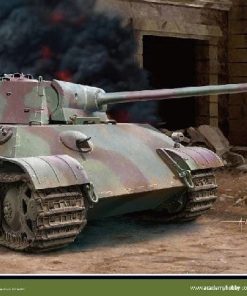AFV Club Military 1/35 Churchill Mk IV AVRE (Armored Vehicle, Royal Engineers) Tank w/Fascine Carrier Frame Kit This Product Usually Ships In 2-3 Business Days
$ 58,39 $ 29,20
Most production A.V.R.E.’s (Armored Vehicle Royal Engineers) were fitted with brackets on the hull for the attachment of fittings for special tasks.
A great example of one of these fittings was the ‘fascine carrier frame’ for carrying fascine bundles tied with steel wire ropes. Ropes were tied with a rope lock with a quick-release mechanism that can be employed to quickly release the wood bundles. because the sight of the driver was blocked by the carrier frame, the driver would need advise from crewmen in the turret to help with directions. Even with this defect, Churchill AVRE fascine carriers still performed efficiently on the battlefields of Normandy.
‘Hobart’s Funnies’ was the name given to these types of unusually modified tanks which operated during the Second World War by the United Kingdom’s 79th Armored Division or by specialists from the Royal Engineers.
They were designed in the light of problems that more standard tanks experienced during the amphibious Dieppe Raid, so that the new models would be able to overcome the problems of the planned Invasion of Normandy. These tanks played a major part on the Commonwealth beaches during the landings. They were forerunners of the modern combat engineering vehicle and were named after their commander, Major General Percy Hobart.
- New tooling fascine carrier frame with delicate wooden texture (lumber bundles not included)
- Steel wire rope, U Shaped shackles and rope lock included
- Churchill Mk.IV cast turret
- Highly detailed petard mortar and armour plates
- Realistic suspension system with metal coil springs
- Mudguards with same parting structure as the real vehicle
- Clear periscope vision blocks included
- Precision photo-etched parts included
Includes markings for:
- 79th Armoured Div., 42nd Assault Regiment, 222nd Assault Sqn. T68434’C Sabre
- 79th Armoured Div., 6th Assault Regiment, 82nd Assault Sqn. T68079 Leveret
- 79th Armoured Div., 6th Assault Regiment, 82nd Assault Sqn. T3217166/C Leopard
- 79th Armoured Div., 6th Assault Regiment, 82nd Assault Sqn. T172540 Loch Ness
Quick Shipping and Professional Packaging
Through our long-term relationship with UPS, FedEx, DHL as well as a range of other top global carriers we can provide an array of shipping options. Our warehouse personnel are extremely skilled and will package your goods in accordance to our precise and exact specifications. Your products will be subjected to an exhaustive examination before they will be securely packaged before being sent out. We ship to thousands clients every day from all over the world. The fact that we are committed to becoming the biggest online retailer in the World is evident. The warehouses are located in Europe just as they are in USA.
Note: Orders that contain more than one product are assigned a specific processing period dependent on the particular item.
Prior to shipment We will inspect thoroughly the items you've ordered. The majority of orders are delivered within 48 hours. The delivery time is between 3 and 7 working days.
Returns
We don't manage the stock at our warehouse or factory. Actual stock levels may fluctuate at any time. Be aware that it's possible that your order could become unavailable even after you've placed your order.
Our policy is valid for a period of 30 days. If it's been more than 30 days since you've bought the item, we unfortunately can't give you a complete exchange or refund.
You are able to return an item if it is unused and is in the same condition the day you received it. It must also be in the original packaging.
Related products
MILITARY MODEL
Academy Military 1/35 M10 GMC US Army Destroyer Normandy Invasion Kit ACCEPTING BACK ORDERS
MODEL AIRPLANES
MILITARY MODEL
Academy Military 1/35 Tiger I Late Version Tank Kit Estimated Shipping: 2-3 Business Days
MILITARY MODEL
Academy Military 1/35 Magach 6B Gal Batash Tank Kit Estimated Shipping: 2-3 Business Days
MILITARY MODEL
Academy Military 1/35 M1151 Enhanced Armament Carrier Kit Estimated Shipping: 2-3 Business Days
MILITARY MODEL
MILITARY MODEL
Academy Military 1/35 German PzKpfw 35(t) Light Tank Kit Estimated Shipping: 2-3 Business Days
MILITARY MODEL
Academy Military 1/35 German Tiger-I Early Version Operation Citadel Kit ACCEPTING BACK ORDERS
MILITARY MODEL
Academy Military 1/35 British M3 Stuart Honey Tank Kit Estimated Shipping: 2-3 Business Days
MODEL AIRCRAFT
MILITARY MODEL
Academy Military 1/35 PzKpfw IV Ausf H Tank Kit Estimated Shipping: 2-3 Business Days
MODEL AIRPLANES
Academy Aircraft 1/35 RQ7B UAV US Aircraft Kit Estimated Shipping: 3-4 Business Days
MILITARY MODEL
MILITARY MODEL
Academy Military 1/35 IDF Merkava Mk III Tank Kit Estimated Shipping: 2-3 Business Days
MILITARY MODEL
Academy Military 1/35 Tiger-I Gruppe Fehrmann Kit Estimated Shipping: 2-3 Business Days
MILITARY MODEL
MILITARY MODEL
Academy Military 1/35 German King Tiger Last Prod Tank Kit Estimated Shipping: 2-3 Business Days
MILITARY MODEL
Academy Military 1/35 Jagdpanzer 38(t) Hetzer Late Tank Kit Estimated Shipping: 2-3 Business Days
MODEL AIRPLANES
Academy Aircraft 1/35 AH60L DAP Black Hawk Helicopter Kit Estimated Shipping: 3-4 Business Days























































